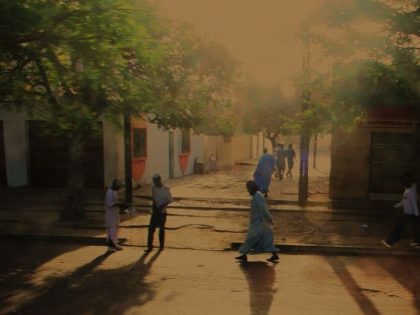The architects of fantasy
Among the Ga people of Ghana, there's more to a coffin and the rituals of death than meets the western eye.

Daniel Anum Jasper paints a lion palanquin at Paa Joe Coffin Works, Accra, Ghana. Image courtesy of author.
A pink fish, a fierce lion, an NBA basketball, or even an octopus. These are all potential shapes for the figurative coffins more popularly known as “fantasy coffins” that are made and used by the Ga people of Ghana. These colorful coffins and the artists that create them have increasingly become more widely known as western circles of academics, museums, collectors, and popular media catch wind of the intriguing cultural practice. A quick scan of recent news articles reveals a focus on the ways these coffins and artists “put the fun in funeral,” “celebrate death in style,” or “spruce up the pine box.” In places like these, the phrase “fantasy coffin” conjures up feelings of unrestrained imagination, images of fantastic—almost unthinkable—shapes, and the sentiments of personal dreams. However, the use of the word “fantasy” to describe these coffins did not originate with the Ga.
The Ga people used to refer to the coffins as abebuu adekai, which roughly translates as “receptacles of proverbs” or “proverbial coffins.” Put simply, coffins that are imbued with some sort of meaning. The practice of making and using figurative coffins arose from changing colonial and postcolonial policies towards the dead in Ghana—they facilitated (and still do) very public statements about familial identity, ancestral power and status in increasingly competitive environments. The cultural significance of their use has been documented in both popular media and scholarship (see Bonetti 2012; Tschumi 2008). So, attaching the qualifier “fantasy” to these coffins and the associated practices lends an overly simplistic and unrealistic sentiment to death and funerals in Ga culture. They are, in fact, highly emotional and complex.
However, within “fantasy coffins” there lies imagination, creativity and personalization coffins, the forms that they take and the people that make them. I discovered this for myself when I visited Paa Joe Coffin Works in Ghana in 2017 to conduct preliminary research for an exhibition of the coffins at the Mathers Museum of World Cultures at Indiana University. There I met Paa Joe, one of the most widely known and respected figurative coffin artists, along with the group of artisans he collaborates with. I witnessed and learned not only about the contemporary processes of making these coffins, but also their significance in an increasingly globalized marketplace.
The creation of these coffins begins with the artists and the people that commission them. Once a shape has been decided upon, either by the deceased’s family, the artist themselves, or a collector, the artists begin to create. Imagination becomes an integral skill for the coffin maker as they consider how to materialize elaborate forms through simple wooden planks, nails, putty and paint. The artists of Paa Joe Coffin Works work primarily from photographs, and rarely sketch out their designs. They rely upon intimate knowledge of materials, technical skill and many years of apprenticing.
While certain forms, such as the fish, are more common and frequently created for both local use and western collection, other more elaborate forms still require careful consideration. Paa Joe tells me that designs, such as the large chameleon that sat in his showroom at the time, can keep him up at night thinking.

These increasingly elaborate “fantasy” forms are most often created for collection and exhibition rather than burial. While I was at the workshop, the staff was working on a variety of projects including an ear of corn coffin for a farmer’s burial, lion palanquins for local chiefs, and a series of sea-themed coffins for an exhibition in Accra. These commissions, which are never intended to enter the ground, give the artists the opportunity to exhibit their skill to wider audiences.
The term “fantasy” does little to express the complex relationships, symbolism and practices associated with the use of these coffins by the Ga people. However, it does evoke the skill and imagination of the artists. Regardless of the academic temptation to focus only on the constructed “authenticity” of coffins for burial and use, the commission of coffins for western collectors and museums, along with overseas artist residencies, now comprises a large portion of the income as well as artistic practices of workshops such as Paa Joe Coffin Works. Paa Joe and his collaborators consider themselves artists. In the documentary Paa Joe and the Lion (2016) that documents their work, Paa Joe states “I can create an image of you out of wood so good that you will greet it in the morning. So yes, I see myself as an artist.”
Paa Joe and his colleagues, together with the artists in other well-known coffin workshops in Ghana, are architects of fantasy who carry on the tradition of abebuu adekai while popularizing coffins on a global scale.



